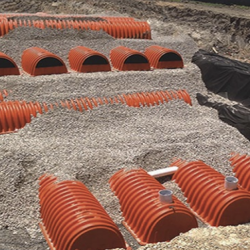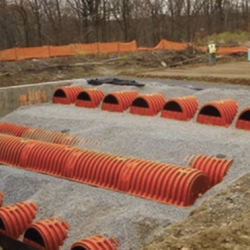CASE STUDY: HOW STORMCHAMBER SYSTEM FITS LIMITED BUDGET, TIGHT URBAN SPACE
STORMCHAMBERS PROVIDES SOLUTION FOR PROJECT WITH LIMITED SPACE

PROBLEM:
The proposed Glenn Hill condo development in Ramapo, N.Y., had encountered a problem that is becoming more and more common in urban areas: Not enough space was available to accommodate traditional storm water management facilities. This problem has been exacerbated in recent years, with economics dictating the acquisition of the smallest possible parcel of land and the need to severely constrain building costs, including those of storm water infrastructure.

SOLUTION:
Such was the case with the Glenn Hill condos project. Constrained by a proposed building property boundary and a utility easement, the storm water system had to be shoehorned into one corner of the site. The engineer, Pratik Desai of Leonard Jackson Associates in Pomona, N.Y., had designed a large-diameter perforated pipe system for storm water detention. Although it t within the tight footprint, the economics required pricing of alternative systems. A triple-stacked StormChamber system was determined to be the least expensive alternative.

RESULTS:
Not only was it less expensive than the large-diameter perforated pipe, but it also was able to t within the small footprint because it could be placed in three layers. This was possible only because the system is capable of supporting more than four times the H-20 Wheel Load Rating (over 32,000 lb per sq ft), as documented by independent laboratory testing. The StormChamber system was able to accommodate the required 24,265 cu ft of storage within a 91 ft by 45 ft area (4,095 sq ft total).